The Celebrity Collector
Peter Marshall has a
house full of antiques
in his French-style country
home
By Ken
Hall
Peter Marshall is
known to millions as the former host of TV's "The Hollywood
Squares," a show so popular in its heyday it was something of a
pop-culture fixture. The shame of it is, many people think that
"Squares" is all Marshall's done, but they're wrong. He's been a
big-band singer, a Broadway and film actor, part of a successful
comedy team, and a nightclub and concert
performer.
Marshall's career
spans about 60 years and has taken him all over the world. During
his travels, he's acquired a taste for antique furnishings. Many of
those pieces today have a place in his California home, one that
took eight years to build by hand. "It's a 4,800-square-foot
authentic French-style country home," Marshall said. "The builder
didn't use nails. He used wooden dowels."
The house was
almost a spur-of-the-moment idea. "I had the contractor (Paul
Burkhart, of Prescott, Ariz.) over to do some work in my former
home, and said to him, 'Why don't we just build a house?'" Marshall
recalled. "Eight years later, it was finally completed" (and, as a
result, Burkhart got a boost and became one of the area's premier
contractors). "My wife, Laurie, and I, really love
it."
The house sits on
an acre, close to Ventura Boulevard and the hustle and pace of
modern life. But the structure itself _ with its old wooden beams,
original hardwood floors and hand-made doors and windows is
from another day and time. The furnishings are the piece de
resistance. All were hand-selected by Marshall.
"I remember being
in London in the early 1960s, when I was appearing on stage in the
play "Bye Bye Birdie" (with Chita Rivera)," Marshall said. "I would
go to the auctions at Christie's and Sotheby's and collect wonderful
things.
Once, I bid on a
lot of over 300 pieces of Patrician Wedgwood, which I love. I
submitted the opening bid, which was something ridiculous, like
$67."
As it turned out,
the auction was being conducted on a holiday, and there were
practically no dealers in the auction hall. "Nobody counter-bid,"
Marshall remembered, laughing. "I got the whole lot, for
$67."
Marshall scored an
even bigger coup in England when he went into the shop owned by a
Mr. Woolsey, who had become a friend. That day, Woolsey's brother
was tending the place. Marshall inquired about a 16th-century oak
end table. "He quoted me a price of about $70 and very quickly I
said okay," Marshall said. "I came back the next day to pick it up
and the other brother was there."
It turned out the
table was one of only two in the world, and the other one was in a
museum in Ireland. "He even showed me a picture of it in a catalog,"
Marshall said. Still, being an upright businessman and recognizing
that a deal is a deal, Mr. Woolsey sold the table to Marshall for
the agreed-upon price. "I can only imagine what the conversation was
like with his brother," he added.
Marshall speaks in
reverent tones about the items in his home, like the 11-foot-tall
window that came out of an old New England church. Or the sliding/
hanging oak door that leads to the bedroom, which he guesses is from
the 1920s. "It's on a runner and makes this loud noise when it's
brought shut," he said. Or the rugged old Irish hutch, the one that
houses the Marshalls' fine china. He bought a magnificent
triple-tressled dining room table in North Dakota that seats 12. "I
had a picker buy it for me,"
Marshall said.
"But it had no chairs. I went to a local antique shop there and the
dealer showed me a picture of some Wavy Ladderback chairs for sale
in Alsace-Lorraine. I fell in love with them and had them shipped
over from France."
Some of his pieces
are doing double-duty, functioning in a way separate from their
originally intended use. A winnower, for example (an old shucking
device, literally used to separate the wheat from the chaff) is now
a coffee table. A French bidet he picked up in Washington, D.C.
(while performing in "La Cage Aux Folles," a role he later reprised
on Broadway), is now used as an end table.
"I don't like
chatchkes," Marshall said emphatically, explaining why there aren't
many knick-knack items on display in his various hutches and display
cabinets. "My wife had some dolls, and she ended up selling them on
eBay." Sadly, one small item a candle holder from the time of
King George I or II (Marshall can't remember which) was stolen out
of the home at a former residence.
Peter Marshall was
born Ralph Pierre LaCock on March 30, 1927, in Huntington, W. Va.
His father, Ralph, was a pharmacist who died when Peter was just 12.
His mother, Jeanne, was a seamstress and aspiring costume designer
who moved the family to New York after Ralph's death, where she got
a job as a saleswoman at Macy's. Peter's older sister, Joanne, began
a career in modeling.
At 14, Peter got a
job as a page at NBC, but singing and acting were his passions. By
the time he was 15, he was already singing in a big band. Joanne
adopted the stage name Joanne Dru and enjoyed some success of her
own. Mom served a year as president of the Motion Picture Mothers
(1975-76). The family thrived in entertainment, but Peter's star
would shine the brightest.
At 22, nearly
broke but still rich with ambition, Marshall moved to Los Angeles,
where he met the comedian Tommy Noonan. The two became friends and
formed a comedy team called Noonan & Marshall. They performed
live and appeared in a few films in the early 1950s. A big break
came when they were booked on "The Ed Sullivan Show." They appeared
on "Sullivan" several times.
Marshall branched
off on his own as the '50s segued into the '60s, mainly as a working
movie actor and in stage productions like "Bye Bye Birdie" in
London. He was in the Warner Bros. sequel to "Mister Roberts,"
titled "Ensign Pulver," and in 1965 gave a fine performance as an
officer trapped underground with a group of allied and enemy troops
in the World War II drama, "The Cavern."
The following year
would change his life forever. NBC was set to launch a new game show
called, "The Hollywood Squares," but didn't have an emcee. In one
story, a network executive saw Marshall's photo on top of a pile of
publicity materials, liked what he saw and asked him to come in to
test. In another story, comic Morey Amsterdam recommended Marshall
to Bert Parks for the role.
"I don't think
either of those versions is true," Marshall said with a laugh. "The
fact is, they wanted a complete non-entity, someone who could come
into the role and pull it off with some humor and spirited chatter,
but who wasn't already known as a game show host. And for that, I
was ideal. I'd done a lot of theatre and film and comedy, but my
face wasn't known to the general public."
It sure became
known by the time the show concluded its enormously successful
15-year run. During that time, Marshall all but ceased his career as
an actor (although he did co-write and appear in the 1968
anti-marijuana film, "Maryjane," starring former teen idol Fabian).
After "Squares," he returned to singing and performed in Big Band
packages, with Harry James' and Les Brown's bands.
Marshall recently
recorded a CD of chart-topping standards, backed by a 30-piece
orchestra. Titled "Peter Marshall, Boy Singer," it is available
through his website, www.boysinger .com. He made another CD, "No
Happy Endings," a tribute to Billie Holiday (also on his website).
And his book, "Backstage With the Original Hollywood Square," is in
bookstores and can be bought at his website.
Today, Marshall is
the morning host of a syndicated radio program (weekdays) on the
Music of Your Life network, which broadcasts tunes from the Big Band
era to about 185 cities nationwide. He is the father of former major
league baseball player Pete LaCock, a one-time #1 draft pick. Fans
of Peter Marshall may write to him c/o GLO Enterprises, 27464
Coldwater Dr., Valencia, CA 91354.
2005
|
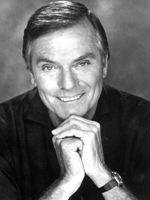
With his good looks and
winning smile, Marshall has enjoyed a 60-year career that includes
TV, stage, film, comedy and singing.
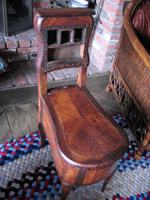
Marshall bought this
French bidet at an auction in Washington, D.C. He uses it as an end
table.
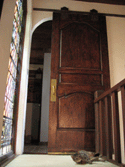
This antique sliding/
hanging
oak door was probably made
in the
1920s.
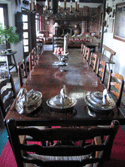
This magnificent old
triple
tressled dining room
table seats 12.
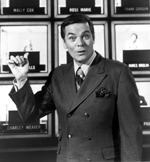
Peter Marshall
hosting
"The Hollywood Squares."
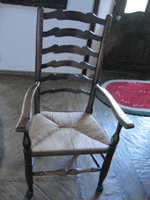
One of 12 wavy
ladderback
chairs purchased for his
dining room
table
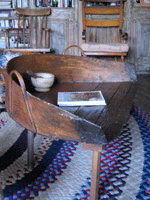
This old winnower is
being
used as a coffee table.
|